|
July 25
Once again we heard lions calling
in the night; it is my abiding impression of the essence of
Africa. We were on the road early again, watching a rose sky at
dawn, the rising sun reflected in the water.
We stopped to watch some francolin
chicks scurrying across the road behind their mother; or were they
spurfowl? I was still a little confused on the difference;
something like francolins are considered spurfowl, but not all spurfowl are francolins
- or was it the other way around?
As we were contemplating these birds, suddenly Jineen
looked over in the other direction and spotted a honey badger.
Unbelievable! It was
near where we had seen one the night before; most likely it was
the same fellow. This time he was much closer, and we got to watch
him as he snuffled around, looking for food.
|
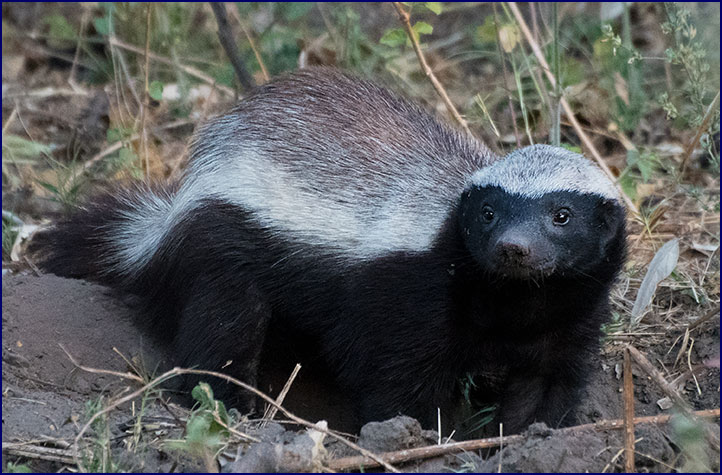
Honey
badger
|
Gee told us that the honey badger, also known as the ratel,
is very tough and hard to kill. His bones are elastic
because they are made of cartilage;
you can run a jeep over him and he is still all right. He can
withstand bee stings and snake venom without harm. Honey badgers
are very fierce, and the other animals fear them. Gee said a honey
badger will never give up. However, if you hit one on the nose, it
will faint. He was chased by them many times as a boy growing up
on the island.
It reminded me of that honey
badger video on the internet: “That
crazy nastyass honey badger. Honey badger don’t care. He
doesn’t give a s#*t.
Our honey badger was scratching through the grass and
leaves, sniffing for food. He started to dig purposefully,
crouching down and using his strong front claws, throwing up a
shower of dirt and dust. Soon he had his head and shoulders down
in the hole, his body curved like a ribbon. From time to time he
would stop and look up at us suspiciously, and then dig some
more.
He caught an earthworm snake and
ate it; we could see the pink strands of it hanging out of his
mouth as he chewed. He raised his head and looked at us, sniffed
warily, and moved on to dig another hole; this time he found a
frog, and quickly devoured it. Honey badger don’t care. Ooh,
that’s nasty!”
|
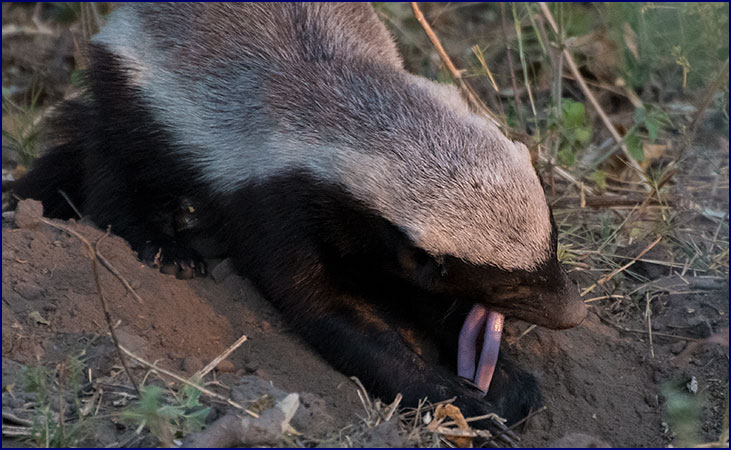
Eating an earthworm
snake
|
Finally
the honey badger moved off, and we did too. We came out by a large
lagoon; a huge mother hippopotamus floated in the water, and
nearby was her small baby, just several months old, hanging out
with a half-grown female who was probably her older sister.
Several others were sleeping along the shore. We could see
scratches and scars all over the big mothers’ back. The older
sister yawned expansively, showing massive incisors, and then
gently snuggled with the baby. There was a partially decayed
elephant carcass in the edge of the lagoon; I tried to avoid
looking at it.
Fred the bushbaby was getting a lot of attention; we passed
another safari vehicle, and when the occupants spotted Fred they
wanted to take selfies with him. I think Duma the baby cheetah was
a little jealous. One of the men told us they had made up a song
to help them find bushbabies. With a bit of urging he sang it for
us; it was to the tune of Matchmaker
from Fiddler on the Roof. He started singing, “Bushbaby, bushbaby . . .
“ I can’t remember
the rest of the words, but surely every bushbaby in the area would
flock to them if they sang that on a night drive.
We drove on, ever in wonder at the
nature all around us. A fish eagle and three vultures perched high
in the same tree. A whole flock of red-billed quelea flew up in
front of us; these were the birds we heard the first evening in
Khwai making chattering cricket-like noise. We saw some zebra and
a couple of ellies, and a jackal in the distance. A lame impala
hobbled across the plain; we figured he would soon be somebody’s
dinner. Gee found a spot he liked and parked the Landcruiser, and
we all got out. We were going for a walk.
Walking safaris were allowed in Khwai, unlike the national
parks. Gee carried a rifle over his shoulder as the rules
required; he had borrowed it for this occasion. He told us to stay
close to him in a line, and he gave us the usual safari
instructions in case we encountered a dangerous animal: Whatever
you do, don’t run!
A walking safari has a different
focus than game driving; it is not a time to try and see large
animals or predators, but rather a chance to observe close-up the
little things that you miss when in the vehicle. We put our
attention on such things as plants, insects, tracks and animal
dung.
|
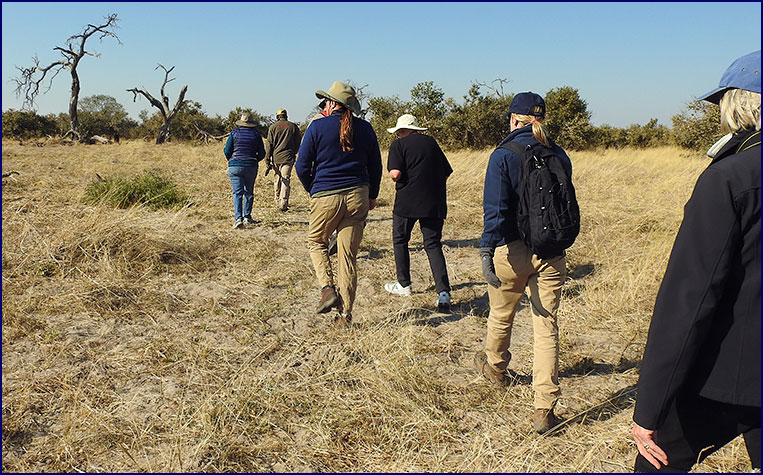
Walking Safari with
Gee
|
We followed Gee across the plain. He was alert, taking our
safety very seriously, scanning the open areas for elephants and
lions constantly. He pointed out different plants and herbs,
telling us of their uses. Cat’s claw for family planning, he
told us; one cup of cat’s claw tea prevents pregnancy for 15
days. He showed us pepper pen plant, which can be used to get rid
of an unwanted pregnancy. I particularly liked the pretty little
curlicue plants that looked like tiny valentines, known as
crowfoot grass.
Remembering hearing about in the past, I asked Gee about
the magic gwarri bush, also known as the toothbrush tree. People
use the roots from this shrub to clean their teeth. Gee said that
he didn’t see any at the moment, but later he would find us a
toothbrush tree so we could try brushing our teeth with it.
Gee examined some elephant dung,
estimating how old it was by the moisture content. It was filled
with large twigs and sticks; the elephants only digest 40% of what
they eat. He told us that if you gathered elephant dung, you could
sell in the city; it is full of many undigested plants and herbs
that are thought to bring strength. People mix it with the fat of
a snake or a lion to protect a newborn baby; they put this mixture
on coals to ‘smoke’ the child, calling on the spirits to
protect the baby from witchcraft. Any bad spirits will see the
lion and elephant spirit in the child, and he will be strong and
safe.
Everywhere we saw wide paths crisscrossing through the
bush, covered with the oval footprints of elephants. Gee called
them elephant highways, and showed us how to interpret them. The
prints are smooth at the back and often have scuff marks on the
front; this is how you can tell which way they were going. When
the elephants are walking quietly, the hind prints are right on
top of the front, like a horse ‘tracking up.’ When they are
running, the hind oval would be well in front of the round front
track. Gee showed us a fresh print, the wrinkles on the bottom of
the elephant’s foot etched clearly in the dusty path; he then
sprinkled sand over the track several times, to show us what it
would look like in a few hours, and in a few days. We also
examined many other tracks, everything from mice to springhares to
impala, to see what had passed this way; this is called reading
the daily news.
Gee kept a constant lookout for dangerous animals,
especially elephants, and explained to us how to find the safe
areas to walk. He showed us an elephant’s bed, an area of
flattened earth with dug-up tusk marks on the ground made from
when it stood up. He said elephants mostly sleep standing up,
especially the mothers, but the youngsters like to like down, and
the bulls do also for short periods.
|
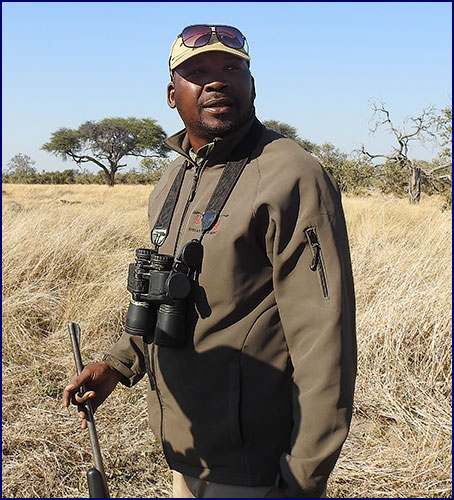
Gee Mange
|
We heard the harsh bark of an
impala alarm call. There was a small herd of the antelopes nearby,
with heads up, staring warily. The impala alarm usually means a
predator so I looked around for a leopard or lion, but then I
realized they were snorting at us – they don’t see us as a
threat when we are in the vehicle, but when we are on foot they
do.
Gee showed us several types of
fresh dung, and quizzed us on what animal had made it. Hyena dung
is green when fresh, but turns white when it dries from the
calcium in all the bones they eat. The tortoises will eat hyena
dung for the calcium it provides. We found some furry turds with a
lot of hair in them, left by a leopard. Springhare dung is pale in
color; Gee told us they eat their own dung. I would rather not
have known that . . .
We stopped beside a large hollow stump; Gee cautioned us
not to reach into it (not that we were considering it!), as there
could be a snake inside, or a leopard might have hidden her baby
there. We sat on a fallen log and took a short break before
heading back to the Landcruiser.
|
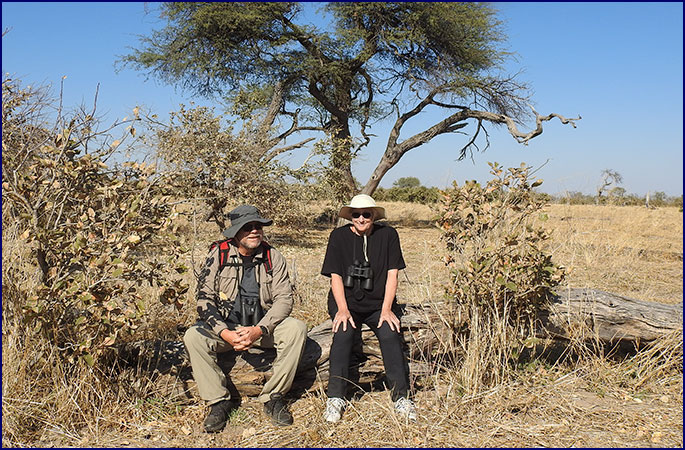
Patty and Rob
|
We never went far without seeing something interesting. We
drove past a herd of zebras, with one youngster lying down taking
a nap. Gee spotted two green wood hoopoes in a tree. A pink-backed
pelican floated on a pond and a white-winged tern bathed in the
shallows.
We stopped for tea beside a
flooded river with many marshy channels. Drowned trees stuck up
out of the water, and a few lilypads floated near the edge. It was
a particularly beautiful spot. There was a herd of waterbucks on
the other side, mostly females and youngsters, with one grand old
buck.
|
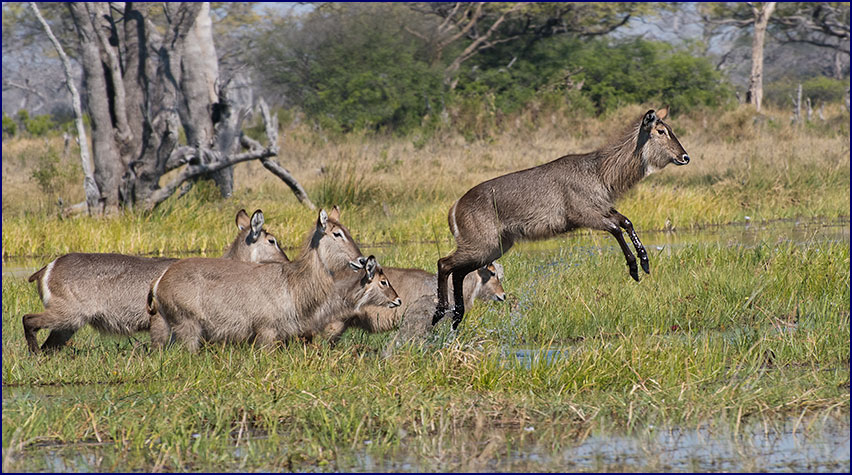
Waterbucks
leaping a channel |
At first the waterbucks were grazing peacefully, but then
they began milling about restlessly, turning their target-marked
rumps toward us. It became evident that they wanted to cross the
river. They all lined up and started moving in a single file row
across in front of us. They splashed through the water, and then
one after another, they leaped spectacularly across the deeper
channels of the river. The females and youngsters went first, and
the buck brought up the rear.
Gee
talked about some of the local cultural beliefs and customs, and
told us a little about the people’s belief in witches, wizards
and witch doctors. He told us this story about his friend’s
brother, Moses:
‘Moses wanted to be a prophet,
so he would have much power. There was an old man in Zambia, a
witch doctor, who could give him this power, but it required Moses
to choose one close family memory to sacrifice. He was willing to
do this, but he needed money to pay the witch doctor. He tried to
borrow money from his brother, he tried to borrow money from me,
and from everyone he knew. He tried to raise the money by getting
his parents to sell some land, or by stealing cattle to sell.
Nobody would help him get the money to become a prophet.
Moses’ brother is a good friend,
and he came to me for help. “Moses needs to sacrifice a close
family member,” he said. “It might be me! Or it may be our
mother, or our sister - we must stop him!” They went to his
parents’ house to try to talk to Moses. The whole family met,
and the brother told everyone of Moses’ plan. Everyone wanted to
know - who would he sacrifice? Moses denied it all, but no one
would give him the money. He went away, and later came back as a
low-level prophet, wearing lots of beads. But he never got the
power that he wanted.’
Traditional healers, or sangomas,
which we would call witch doctors, are still a big part of the
culture in Botswana. If you get sick or your cattle die, maybe
somebody cast an evil spell on you. You would go to a witch doctor
to get that spell taken off. Or you might pay a sangoma
to put a spell on your enemy, calling on the evil spirits. It all
seems very strange to us, but when you are there in Botswana and
hear the stories firsthand - well, anything seems possible.
As we continued on we saw another Letaka group, and we
watched as a huge bull elephant with enormous crooked tusks walked
slowly by their Landcruiser, passing within inches. It was
interesting to observe how small the Landcruisers are compared to
the elephants. Gee handed the rifle over to the other guide, who
needed it to take his clients walking.
As we drove back along the river, all of the usuals were
about; kudus under the trees, impalas in the sunlight and a family
of zebras across the river. A kudu and an impala grazed together,
the size difference making them look like mother and baby. We
passed a huge black mamba hotel, about four meters tall. Gee said
this termite mound was probably about 60 years old; it is about
ten years for every meter in height, but this one used to be
taller before being eroded away.
We saw a prickly yellow and orange
fruit, somewhat cactus-like; Gee said it was a wild cucumber.
Ostriches and porcupines get their water from eating these, like
summer melons. Ostriches do not need to drink water; they get
enough from the fruit.
Gee pointed out some plants with
round ball-like blooms which he called African Daga (pronounced Da
Ha); he said it is a natural marijuana plant, and you can smoke
the leaves or the balls. Jineen and Patty discussed plans for
collection and harvest.
We saw a great many birds along the river. A pied
kingfisher perched on a thornbush, and a long-toed lapwing guarded
her nest in the grass. Only the snakelike head and neck of a
darter was visible above the water as it swam downstream. We saw a
glossy ibis, similar to the hadada, with shimmery green on its
wings. A grey-backed camaroptera, sometimes known as a bleating
warbler, flitted through the bushes. A squacco heron flew along
over the river, and a spur-winged goose waded in the shallow
water. A beautiful coppery-tailed coucal stood in the grass,
gazing up at us with his bright red eyes.
|
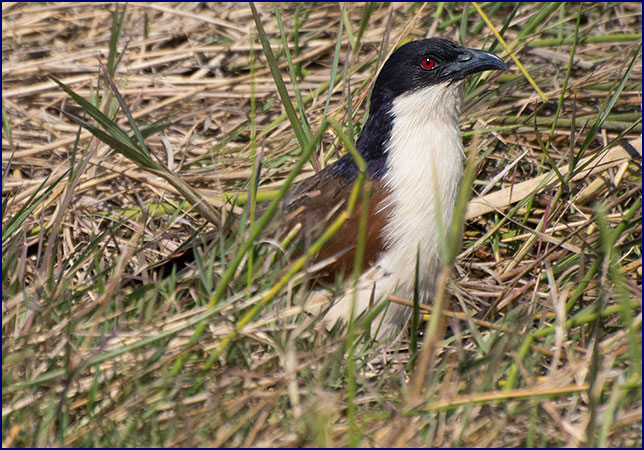
Coppery-tailed
coucal |
A hamerkop came gliding in for a landing, then waded into a
shallow water channel. These medium-sized brown birds have a
hammer-shaped head and a sturdy build. They are a rather drab
muddy brown color, and are somehow a bit prehistoric-looking. They
are interesting looking more than handsome – and yet there is
something about them I find really appealing. The hamerkop steals
clothes, shoes, and whatever else it can find to build huge
elaborate nests.
|

Hamerkop
|
A goliath heron stood in the reeds, and as we approached it
rose up and flew away on slow motion wings. It is an elegant slate
grey bird with mottled rufous and white markings on its neck and
underside. The world’s largest heron, the goliath is an
endangered species. We caught up with it again at the next bend in
the river for a closer look. A Nile crocodile lurked among the
lilypads, clean and brown with pale green eyes.
|
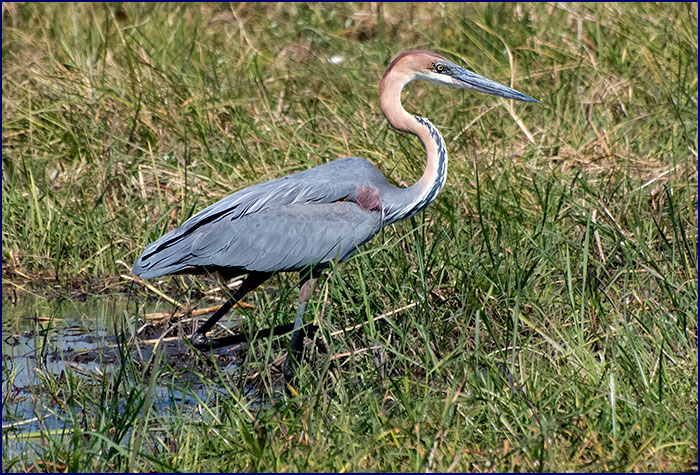
Goliath heron |
Heading back to camp, a herd of female impalas ran across
the road in front of us, tightly packed together, alarmed at
something. Then they stopped and milled about, apparently
forgetting about whatever danger they had perceived. We admired
their elegant refined faces and big dark eyes; it is easy to take
the impala for granted because they are so common, but they really
are quite beautiful.
Phillimon greeted us with the usual goblets of sweet bush
tea; I would have to remember to get the recipe for that tea! We
had cheeseburgers for lunch, and then relaxed and enjoyed the
view. I could see the lagoon from my tent window, and the dining
table was right beside the water. The Landcruiser was parked
nearby. The kitchen and staff tents were a little ways off and we
stayed out of that area to respect their privacy, but Phillimon
stood on a termite mound and waved to us.
|
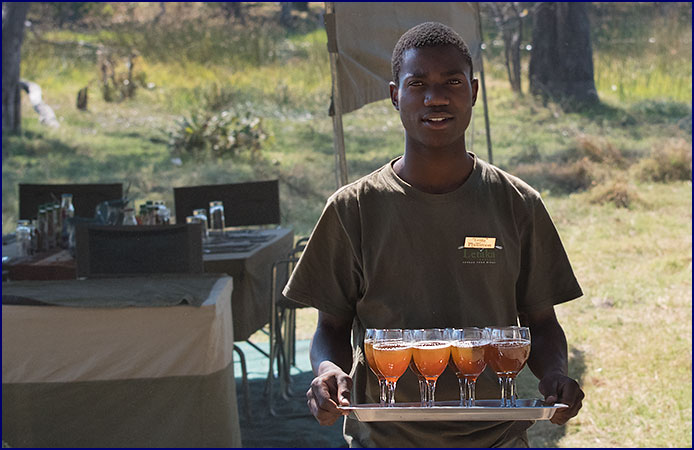
Phillimon
|
I took some photos around camp. Sadly, my Coolpix camera
was dead; it would no longer work after being dropped the previous
day - a blacksmith plover down by the river was the last photo it
would take. I would miss having that zoom lens for the rest of the
trip; it was not my best quality camera, but it did have the
greatest telephoto range.
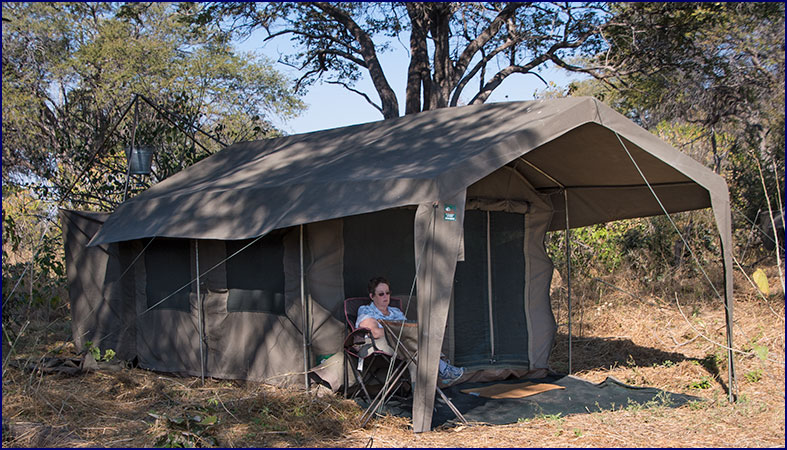
Paula at her tent
|
As we were just heading out on the afternoon drive we heard
loud crashing noises; an elephant came through the edge of the
camp, noisily breaking branches off the trees. Rob said it sounded
like giants walking in a forest. There was a big warthog just
outside camp; he turned and showed us his backside. A bit further
on a beautiful female red-crested korhaan walked through the
underbrush; she had long legs, large eyes and variegated brown,
black and white plumage.
We were driving through the woods when suddenly there were
elephants all around us, moving through scrubby trees barely
taller than they were. It was a breeding herd, and the mothers
were shielding the smaller babies from view. We stopped to let
them pass, and within a few minutes, they had all disappeared into
the trees. It is amazing how one moment there can be a dozen
elephants in full view, and a few seconds later they have vanished
without a trace.
The herd came back into view and began to feed, and we sat
and watched them. The elephants would break off a branch and eat
it, then go to another tree and repeat the process. Tara asked why
they kept moving so much; Gee explained that when the elephants
start to eat, the tree releases a bad-tasting tannin for
protection, so the ellies move on to the next tree.
A dainty steenbok stood in the yellow grass; he was a
delicate, exquisite creature. He had big ears, sharp straight
horns and a petite refined face. He seemed like a creature out of
a story book; one wasn’t quite sure if he was real.
|
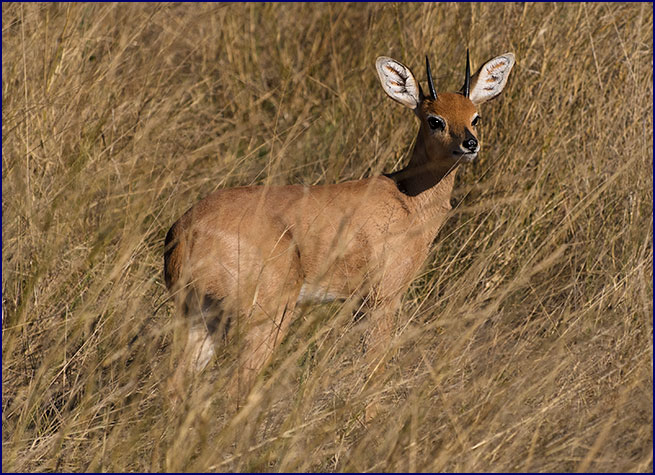
Steenbok |
A bit further on we paused to watch an elephant taking a
dust bath - but he came out of the dust wallow and moved toward us
aggressively; Gee said he was in musth, and drove off quickly. A
few minutes later we came across yet another angry bull elephant;
he was striding angrily in front of us, stomping up great clouds
of dust. He was looking for females and seemed very bad tempered.
Another musth fellow? It must be something in the water! We
yielded the right of way to him.
We were hoping to see some cape buffalo, but the closest we
got was a cape turtle dove. These handsome birds are a pale
greyish-brown color with a tinge of pink, and have a black ring
around the back of their necks. They can often be heard making a
repeating chant-like call; it always sounds to me like they are
calling Bots-wa-na, Bots-wa-na.
But Gee has another interpretation; he says in the morning
they are calling work hard-er, work hard-er, but in the evening they switch to drink
lag-er, drink lag-er.
|

Cape turtle dove |
We
saw a couple more new birds; a brilliantly speckled groundscraper
thrush and a tiny rattling cisticola. Rob was very intrigued by
some spider nests in the trees, made from very dense web. And a
couple of my favorite birds were there; a pair of brilliantly
colored little bee-eaters sat on a twig, and a Burchell’s
starling perched on top of a tree, glistening blue in the sun.
|
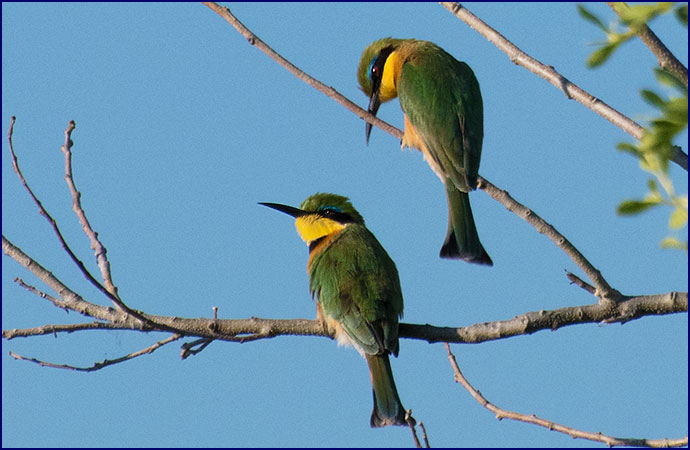
Little bee-eaters
|
We stopped to check out the hyena den; one adult female was
stretched out on the ground by the entrance. Gee said she was a
mother; we waited, hoping the babies would come out of the den.
The hyena looked like she was fast asleep, but when we approached
she opened her eyes and looked at us with a keen expression.
We sat watching her for a while,
and also looking around at the surroundings. Gee pointed out a
tree with pointy knobs all over the trunk called a knobthorn
acacia. The meadow was filled with beautiful golden grasses that
took on the shape of feathery ferns and delicate curlicues.
Gee told us that hyenas steal dens
from aardvarks, and then the warthogs will steal them from the
hyenas. He said that hyenas are primarily scavengers, though they
will also hunt if needed. I loved the way Gee pronounced
scavengers with the accent on the middle syllable: Sca-VEN-gers
(like avengers). The
hyena briefly raised her head for a moment and looked around
lazily, then flopped back down on her side again. We left her
slumbering.
Gee pointed out several toothbrush trees, but he said these
were too large; it is better to use the roots of smaller shrubs so
they aren't too big and tough. He promised to find us some the
next day, so we could brush our teeth the traditional way.
A business of nine dwarf mongooses
climbed on top of an old termite hill; half a dozen youngsters
played on the top while several adults kept watch. One of the
sentinels stood on its hind legs watching us closely. Would the
plural be mongooses, or mongeese?
|
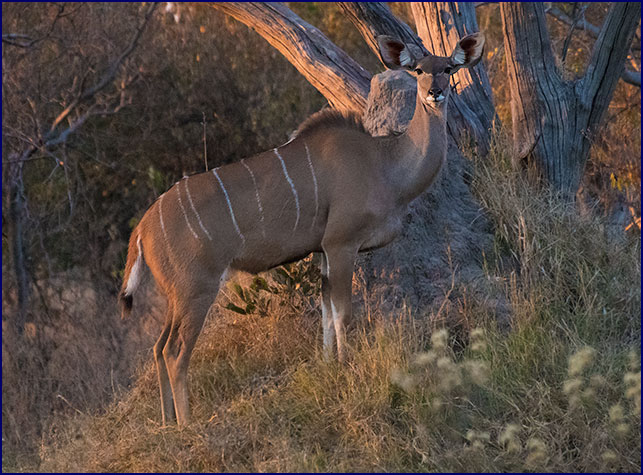
Kudu
doe at sunset |
Entering a wooded area, there were two beautiful female
kudus. One was surrounded by tall grass, and the other stood on a
termite mound beneath a large tree. The late afternoon sun bathed
them in delicate light, and I felt like we were in an enchanted
forest. Just as the light was beginning to fade, the kudu bull
came walking out of the trees. He had towering spiral horns and a
terrific mane beneath his neck. It was beautiful, surreal; they
were like dream kudus, surely magical.
We watched the sun lowering between the trees, turning the
sky to crimson and orange. Then we went out onto the floodplain;
four lechwe stood bathed in red-gold light, and an elephant ambled
across in the background.
We stopped for Sundowners beside a
huge lagoon. The sky, fiery red near the sun, faded from magenta
to dusky rose to a deep blue above. As the huge disc of the sun
slipped below the horizon, a colony of egrets perched in a bare
tree were silhouetted against the red sky. We could just make out
the dark forms of crocodiles along the edge of the water.
As the sky darkened we could see the crescent moon, just
barely thicker than the night before, still hanging horizontal
like a smile; we couldn’t remember ever seeing it in quite that
position at home. The brilliant colors along the horizon lasted
long after the sun had slipped away.
We stood by the vehicle, sipping a
glass of wine and enjoying the peaceful evening. We could hear
elephants trumpeting and splashing, and hippos honking in the
night. Gee passed around a Sundowners snack; chunks of banana
wrapped in bacon – they were surprisingly good.
Night falls quickly in Africa;
near the poles the sun moves more horizontally through the sky
(think of how it barely dips below the horizon in Alaska in
summer), but near the equator it drops straight down, going from
daylight to dark very quickly.
As we began packing up, Paula said “Don’t leave me”
and made a quick trip behind a bush. This turned the conversation
to what would happen if we were
left out there. If somehow Gee took off and left us at the lagoon
for the night, would we survive, or end up as somebody’s dinner?
Fortunately we did not have to put it to the test.
It was pitch dark as we headed back to camp. An
elephant was in the water where the road forded a stream; as we
waited for him to cross, Gee carefully averted the spotlight,saying the elephant would be angry if we shined it in his eyes. We
passed close to a grazing hippo – this was the nearest we had
been to one out of the water. Gee said they can weight up to 2 ½
tons. We saw more springhares; I never get enough of them.
Gee stopped the Landcruiser and we
sat and listened to the night sounds – always one of my favorite
parts of the night drives. Gee told us a story from his childhood
about being left alone on his family’s island. His parents went
to town in the mokoro to sell palm wine, but they got drunk and
didn’t come home until after midnight. He was quite young at the
time, and he was responsible for taking care of his younger
siblings. When it got dark and his parents had not come back, he
became quite scared. He could hear jackals, owls, hippos. Were bad
spirits coming? He did not know what to do. Finally he could hear
his parents singing as they came back to the island in the mokoro.
After that is when he got to know the bush; he learned all about
the animals and how to get around safely in the wild. That is the
difference between Gee and the other guides; he grew up in the
bush, and knows it in a way that few do.
We
had fish and chips for dinner; not exactly the meal you expect to
be served in the wilds of Africa, but it was excellent. We were
constantly amazed at what Pula and the others could cook using
camp stoves and Dutch ovens. Around the campfire we could hear
trumpeting elephants for a long time - must be another bull in
musth.
|